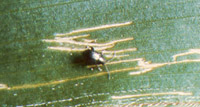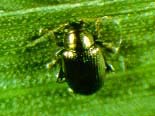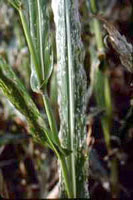Description
The adult is a very small, smooth, shiny, roundish, black beetle.
The hind legs are distinctly enlarged and thickened, and the
beetles jump readily when approached. The larvae are small,
white, and not very active. Full-grown larvae are 1/6 in. long
and most body segments are nonpigmented. Only the prothorax
and the last abdominal segment are slightly darkened. |
Click
on image for larger version

Figure
1. Corn Flea Beetle Adult and Damage to Leaf
|
|
Click
on image for larger version

Figure 2. Adult Corn Flea Beetle
|
Life
Cycle
The corn flea beetle passes the winter as an adult, hibernating
in debris and other suitable cover in fencerows, roadsides,
or the edges of woodlands. It becomes active early in the spring
and even feeds on grasses on warm days during the winter. After
mating, the females lay their eggs on plant leaves or in the
ground, on or near underground stems and roots. Not much is
known about the larvae, but they probably feed on the roots
of grass plants. In Illinois, the larvae complete growth, pupate,
and emerge as adults during June. They lay eggs for another
generation; the second-generation adults appear in early August
and feed until late in the fall before entering winter quarters. |
Damage
Little is known about damage caused by the larvae, but damage
by the adults is very evident. They feed on both the upper and
the lower epidermis of corn leaves, but they do not chew completely
through the leaves. When adults are abundant early in the spring,
they will feed heavily on the primary leaves and first three
or four true leaves, often causing the seedling to appear whitish
or silvery and sometimes killing the plant. Luring June and
August, when the newly emerged adults appear, the leaves of
corn may be partly covered with their feeding scars. |
Click
on image for larger version

Figure 3. Corn Flea Beetle Damage
|
During
the feeding process, the adults disseminate a bacterial wilt of
corn called Stewart's disease. This disease infests the water-conducting
tissues of the plant. Generally, field corn infested with Stewart's
disease will show little sign of disease until late in the summer
when numerous leaf lesions will appear on the leaves. However, in
years when flea beetles are abundant and the disease is widely disseminated,
some varieties of corn will wilt and the plants may die before tasseling.
Drought can aggravate or accentuate the diseased condition of a
plant. The result is often small ears or no ears at all. When conditions
are favorable for both the beetles and the wilt, nearly 100 percent
of the susceptible varieties of field corn will show symptoms of
Stewart's disease by late fall.
Evidence
of Stewart's disease is more common and the results more drastic
in sweet corn than in field corn. A large percentage of sweet corn
plants infested in the seedling stage will die or dwarf and produce
no harvestable ears. Plants not showing these drastic effects may
produce normal ears if they get plenty of water.
The
bacteria that cause Stewart's disease, or bacterial wilt of corn,
overwinter in the body of the adult corn-flea beetle. Because the
corn-flea beetle is verv sensitive to temperatures, a criterion
to predict the extent of overwintering heetles has been developed
called the Winter Temperature Index. This index is based on the
suin of the average monthly temperatures for December, January,
and February. A sum of 100 and above for the three months indicates
that the wilt phase of Stewart's disease will probably be severe;
a sum of 90-100 indicates a moderate wilt infection, ranging from
light to severe, depending on the area. Slight infection may occur
when the sum totals 85-90, and no infection will occur below 85.
Scouting
Procedures
Examine newly emerged corn for the presence of the beetles and count
the approximate number per plant. They will first appear around
field edges as they move from grassy areas and other overwintering
sites.
Threshold
Guide
Control may be justified when there is an average of 5 or more beetles
per plant prior to the 4-leaf stage. If the infestation is so severe
that some plants are being killed, or if more than half of the leaves
are whitish, it may be profitable to treat.
Although
feeding damage is seldom economic, the beetles can transmit Stewart’s
disease to susceptible varieties of corn. Most varieties of commercial
field corn are resistant to this diseases. In a situation where
the corn variety is susceptible to Stewart’s disease, control
should be applied as soon as flea beetles have been detected, even
in low numbers.
Control
The Winter Temperature Index is useful in indicating the probability
of wilt infection for the coming season. When the index suggests
successful overwintering of beetles, damage can be reduced by avoiding
early planting and by planting resistant varieties of field or sweet
corn.
Authors:
Susan T. Ratcliffe (sratclif@uiuc.edu)
Michael E. Gray (m-gray4@uiuc.edu)
Kevin L. Steffey (ksteffey@uiuc.edu)
|

